Aggregation of Gold Nanoparticles Caused in Two Different Ways Involved in 4-Mercaptophenylboronic Acidand Hydrogen Peroxide
Abstract
:1. Introduction
2. Experimental
2.1. Materials
2.2. Synthesis of Gold Nanoparticles
2.3. Reaction Conditions Involved in the Investigation
2.4. Characterization Techniques
3. Results and Discussion
3.1. The UV-Vis Spectroscopy for the Interaction between 4-MPBA and the Citrate-Capped AuNPs
3.2. The UV-Vis Spectroscopy of AuNP Solutions Containing 4-MPBA and H2O2
3.3. The Products Formed in the Reaction between 4-MPBA and H2O2
3.4. The Aggregation of AuNPs Caused by the Interaction of 4-MPBA and H2O2
4. Conclusions
Supplementary Materials
Author Contributions
Funding
Conflicts of Interest
References
- Elghanian, R.; Storhoff, J.J.; Mucic, R.C.; Letsinger, R.L.; Mirkin, C.A. Selective colorimetric detection of polynucleotides based on the distance-dependent optical properties of gold nanoparticles. Science 1997, 277, 1078–1081. [Google Scholar] [CrossRef] [PubMed]
- Ghosh, S.K.; Pal, T. Interparticle coupling effect on the surface plasmon resonance of gold nanoparticles: from theory to applications. Chem. Rev. 2007, 107, 4797–4862. [Google Scholar] [CrossRef]
- Cambre, J.N.; Sumerlin, B.S. Biomedical applications of boronic acid polymers. Polymer 2011, 52, 4631–4643. [Google Scholar] [CrossRef] [Green Version]
- Fang, H.; Kaur, G.; Wang, B. Progress in boronic acid-based fluorescent glucose sensors. J. Fluoresc. 2004, 14, 481–489. [Google Scholar] [CrossRef] [PubMed]
- Springsteen, G.; Wang, B. A detailed examination of boronic acid-diol complexation. Tetrahedron 2002, 58, 5291–5300. [Google Scholar] [CrossRef]
- Yan, J.; Fang, H.; Wang, B. Boronolectins and fluorescent boronolectins: An examination of the detailed chemistry issues important for the design. Med. Res. Rev. 2005, 25, 490–520. [Google Scholar] [CrossRef] [PubMed]
- Keshvari, F.; Bahram, M.; Farhadi, K. A selective, sensitive and label-free visual assay of fructose using anti-aggregation of gold nanoparticles as a colorimetric probe. Chin. Chem. Lett. 2016, 27, 847–851. [Google Scholar] [CrossRef]
- Sankoh, S.; Thammakhet, C.; Numnuam, A.; Limbut, W.; Kanatharana, P.; Thavarungkul, P. 4-Mercaptophenylboronic acid functionalized gold nanoparticles for colorimetric sialic acid detection. Biosens. Bioelectron. 2016, 85, 743–750. [Google Scholar] [CrossRef]
- Keshvari, F.; Bahram, M. Selective, sensitive and reliable colorimetric sensor for catechol detection based on anti-aggregation of unmodified gold nanoparticles utilizing boronic acid–diol reaction: optimization by experimental design methodology. J. Iran. Chem. Soc. 2017, 14, 977–984. [Google Scholar] [CrossRef]
- Zhou, Y.; Dong, H.; Liu, L.; Li, M.; Xiao, K.; Xu, M. Selective and sensitive colorimetric sensor of mercury (II) based on gold nanoparticles and 4-mercaptophenylboronic acid. Sens. Actuat. B 2014, 196, 106–111. [Google Scholar] [CrossRef]
- Kong, Y.; Shen, J.; Fan, A. Colorimetric method for the detection of mercury ions based on gold nanoparticles and mercaptophenyl boronic acid. Anal. Sci. 2017, 33, 925–930. [Google Scholar] [CrossRef]
- Jiang, G.; Zhu, W.; Shen, X.; Xu, L.; Li, X.; Wang, R.; Liu, C.; Zhou, X. Colorimetric and visual determination of adenosine triphosphate using a boronic acidas the recognition element, and based on the deaggregation of gold nanoparticles. Microchim. Acta 2017, 184, 4305–4312. [Google Scholar] [CrossRef]
- Kong, B.; Zhu, A.; Luo, Y.; Tian, Y.; Yu, Y.; Shi, G. Sensitive and selective colorimetric visualization of cerebral dopamine based on double molecular recognition. Angew. Chem. Int. Ed. 2011, 50, 1837–1840. [Google Scholar] [CrossRef]
- Wallace, G.Q.; Tabatabaei, M.; Zuin, M.S.; Workentin, M.S.; Lagugné-labarthet, F. A nanoaggregate-on-mirror platform for molecular and biomolecular detection by surface-enhanced Raman spectroscopy. Anal. Bioanal. Chem. 2016, 408, 609–618. [Google Scholar] [CrossRef]
- Zhang, K.; Wang, Y.; Wu, M.; Liu, Y.; Shi, D.; Liu, B. A novel SERS nanoprobe for the ratiometric imaging of hydrogen peroxide in living cells. Chem. Commun. 2016, 52, 8553–8556. [Google Scholar]
- Gu, X.; Wang, H.; Schultz, Z.D.; Camden, J.P. Sensing glucose in urine and serum and hydrogen peroxide in living cells by use of a novel boronate nanoprobe based on Surface-Enhanced Raman Spectroscopy. Anal. Chem. 2016, 88, 7191–7197. [Google Scholar] [CrossRef]
- Yang, Y.-C.; Tseng, W.-L. 1,4-Benzenediboronic-acid-induced aggregation of gold nanoparticles: Application to hydrogen peroxide detection and biotin-avidin-mediated immunoassay with naked-eye detection. Anal. Chem. 2016, 88, 5355–5362. [Google Scholar] [CrossRef]
- Ananthi, A.; Naresh Kumar, T.; Mathiyarasu, J.; Joseph, J.; Phani, K.L.N.; Yegnaraman, V. A novel potentiometric hydrogen peroxide sensor based on pKa changes of vinyl phenylboronic acid membranes. Mater. Lett. 2011, 65, 3563–3565. [Google Scholar] [CrossRef]
- Bastús, N.G.; Comenge, J.; Puntes, V. Kinetically controlled seeded growth synthesis of citrate-stabilized gold nanoparticles of up to 200 nm. Langmuir 2011, 27, 11098–11105. [Google Scholar] [CrossRef]
- Bowey, K.; Tanguay, J.-F.; Sandros, M.G.; Tabrizian, M. Microwave-assisted synthesis of surface-enhanced Raman scattering nanoprobes for celluar sensing. Colloids Surf. B 2014, 122, 617–622. [Google Scholar] [CrossRef]
- Vancoillie, G.; Hoogenboom, R. Synthesis and polymerization of boronic acid containing monomers. Polym. Chem. 2016, 7, 5484–5497. [Google Scholar] [CrossRef]
- Singh, G.; Bremmell, K.E.; Griesser, H.J.; Kingshott, P. Colloid-probe AFM studies of the interaction forces of proteins adsorbed on colloidal crystals. Soft. Matter. 2015, 11, 3188–3197. [Google Scholar] [CrossRef]
- Miao, X.; Ning, X.; Li, Z.; Cheng, Z. Sensitive detection of miRNA by using hybridization chain reaction coupled with positively charged gold nanoparticles. Sci. Rep. 2016, 6, 32358. [Google Scholar] [CrossRef] [Green Version]
- Jiang, Y.; Zhao, H.; Lin, Y.; Zhu, N.; Ma, Y.; Mao, L. Colorimetric detection of glucose in rat brain using gold nanoparticles. Angew. Chem. Int. Ed. 2010, 49, 4800–4804. [Google Scholar] [CrossRef]
- Liu, L.; Chang, Y.; Xia, N.; Peng, P.; Zhang, L.; Jiang, M.; Zhang, J.; Liu, L. Simple, sensitive and label–free electrochemical detection of microRNAs based on the in situ formation of silver nanoparticles aggregates for signal amplification. Biosens. Bioelectron. 2017, 94, 235–242. [Google Scholar] [CrossRef]
- Xia, N.; Cheng, C.; Liu, L.; Peng, P.; Liu, C.; Chen, J. Electrochemical glycoprotein aptasensors based on the in-situ aggregation of silver nanoparticles induced by 4-mercaptophenylboronic acid. Microchim. Acta 2017, 184, 4393–4400. [Google Scholar] [CrossRef]
- Liu, L.; Sun, T.; Ren, H. Electrochemical detection of hydrogen peroxide by inhibiting the p-benzenediboronic acid-triggered assembly of citrate-capped Au/Ag nanoparticles on electrode surface. Materials 2017, 10, 40. [Google Scholar] [CrossRef]
- Zhang, C.; Liang, X.; You, T.; Yang, N.; Gao, Y.; Yin, P. An ultrasensitive “turn-off” SERS sensor for quantitatively detecting heparin based on 4-mercaptobenzoic acid functionalized gold nanoparticles. Anal. Methods 2017, 9, 2517–2522. [Google Scholar] [CrossRef]
- Zhang, J.; He, L.; Zhang, X.; Wang, J.; Yang, L.; Liu, B.; Jiang, C.; Zhang, Z. Chemical colorimetric and SERS dual-readout for assaying alkaline phosphatase activity by ascorbic acid induced aggregation of Ag coated Au nanoparticles. Sens. Actuators B 2017, 253, 839–845. [Google Scholar] [CrossRef]
- Chen, S. 4-Hydroxythiophenol-protected gold nanoclusters in aqueous media. Langmuir 1999, 15, 7551–7557. [Google Scholar] [CrossRef]
- Buytendyk, A.M.; Graham, J.D.; Collins, K.D.; Bowen, K.H.; Wu, C.-H.; Wu, J.I. The hydrogen bond strength of the phenol – phenolate anionic complex: A computational and photoelectron spectroscopic study. Phys. Chem. Chem. Phys. 2015, 17, 25109–25113. [Google Scholar] [CrossRef]
- Pizer, R.; Tihal, C. Peroxoborates. Interaction of boric acid and hydrogen peroxide in aqueous solution. Inorg. Chem. 1987, 26, 3639–3642. [Google Scholar] [CrossRef]
- Hiebel, M.-A.; Berteina-raboin, S. Iodine-catalyzed region selective sulfenylation of imidazoheterocycles in PEG400. Green Chem. 2015, 17, 937–944. [Google Scholar] [CrossRef]
- Oae, S.; Yoshihara, M. Polar conjugative effect of aryldithia group on the dissociation and ultraviolet spectra of substituted phenols. Bull. Chem. Soc. Jpn. 1968, 41, 2082–2086. [Google Scholar] [CrossRef]
- Deary, M.E.; Durrant, M.C.; Davies, D.M. A kinetic and theoretical study of the borate catalysed reactions of hydrogen peroxide: The role of dioxaborirane as the catalytic intermediate for a wide range of substrates. Org. Biomol. Chem. 2013, 11, 309–317. [Google Scholar] [CrossRef]
- Biswas, A.; Malferrari, S.; Kalaskar, D.M.; Das, A.K. Arylboronate esters mediated self-healable and biocompatible dynamic G-quadruplex hydrogels as promising 3D-bioinks. Chem. Commun. 2018, 54, 1778–1781. [Google Scholar] [CrossRef]
- Coddington, J.M.; Taylor, M.J. High field 11B and13C NMR investigations of aqueous borate solutions and borate-diol complexes. J. Coord. Chem. 1989, 20, 27–38. [Google Scholar] [CrossRef]
- Brikh, A.; Morin, C. Boronated thiophenols: A preparation of4-mercaptophenylboronic acid and derivatives. J. Organomet. Chem. 1999, 581, 82–86. [Google Scholar] [CrossRef]
- Kawaguchi, A.W.; Sudo, A.; Endo, T. Thio- functionalized 1,3-benzoxazine: preperation and its use as a precursor for highly polymerizable benzoxazine monomers bearing sulfide moiety. J. Polym. Sci. Part A Polym. Chem. 2014, 52, 1448–1457. [Google Scholar] [CrossRef]
- Chatterjee, T.; Ranu, B.C. Aerobic oxidation of thiols to disulfides under ballmilling in the absence of any catalyst, solvent, or base. RSC Adv. 2013, 3, 10680–10686. [Google Scholar] [CrossRef]
- Charisiadis, P.; Kontogianni, V.G.; Tsiafoulis, C.G.; Tzakos, A.G.; Siskos, M.; Gerothanassis, I.P. 1H-NMR as a structural and analytical tool of intra- and intermolecular hydrogen bonds of phenol-containing natural products and model compounds. Molecules 2014, 19, 13643–13682. [Google Scholar] [CrossRef]
- Chaudhari, S.R. Screening and assignment of phenylboronic acid and its anhydride formation by NMR spectroscopy. Chem. Phys. Lett. 2015, 634, 95–97. [Google Scholar] [CrossRef]
- Su, H.; Wang, Y.; Yu, Z.; Liu, Y.; Zhang, X.; Wang, X.; Sui, H.; Sun, C.; Zhao, B. Surface-enhanced Raman spectroscopy study on the structure changes of4-mercaptophenylboronic acid under different pH conditions. Spectrochim. Acta Part A 2017, 185, 336–342. [Google Scholar] [CrossRef]
- Xu, H.; Li, D.; Zhao, Y.; Wang, X.; Li, D.; Wang, Y. Sodium 4- mercaptophenolate capped CdSe/ZnS quantum dots as a fluorescent probe for pH detection in acidic aqueous media. Luminescence 2018, 33, 410–416. [Google Scholar] [CrossRef]
- Cardey, B.; Enescu, M. Selenocysteine versus cysteine reactivity: A theoretical study of their oxidation by hydrogen peroxide. J. Phys. Chem. A. 2007, 111, 673–678. [Google Scholar] [CrossRef]
- Quesada, A.R.; Byrnes, R.W.; Krezoski, S.O.; Petering, D.H. Direct reaction of H2O2 with sulfhydryl groups in HL-60 Cells: Zinc-metallothionein and other sites. Arch. Biochem. Biophys. 1996, 334, 241–250. [Google Scholar] [CrossRef]
- Shiang, Y.-C.; Huang, C.-C.; Chang, H.-T. Gold nanodot-based luminescent sensor for the detection of hydrogen peroxide and glucose. Chem. Commun. 2009, 23, 3437–3439. [Google Scholar] [CrossRef]
- Ruano, J.L.G.; Parra, A.; Alemán, J. Efficient synthesis of disulfides by air oxidation of thiols under sonication. Green Chem. 2008, 10, 706–711. [Google Scholar] [CrossRef]
- Sasaki, S.; Sutoh, K.; Yoshifuji, M. Synthesis, structure, and reactivity of 2, 6-Diaryl-4-hydroxybenzenethiol. Heteroat. Chem. 2014, 25, 442–448. [Google Scholar] [CrossRef]
- Yuan, L.-F.; He, Y.-J.; Zhao, H.; Zhou, Y.; Gu, P. Colorimetric detection of D-amino acids based on anti-aggregation of gold nanoparticles. Chin. Chem. Lett. 2014, 25, 995–1000. [Google Scholar] [CrossRef]
- Nurpeissova, Z.A.; Alimkhanova, S.G.; Mangazbayeva, R.A.; Shaikhutdinov, Y.M.; Mun, G.A.; Khutoryanskiy, V.V. Redox- and glucose-responsive hydrogels from poly(vinyl alcohol) and 4-mercaptophenylboronic acid. Eur. Polym. J. 2015, 69, 132–139. [Google Scholar] [CrossRef] [Green Version]
- Li, S.; Zhou, Q.; Chu, W.; Zhao, W.; Zheng, J. Surface-enhanced Raman scattering behaviour of 4-mercaptophenyl boronic acid on assembled silver nanoparticles. Phys. Chem. Chem. Phys. 2015, 17, 17638–17645. [Google Scholar] [CrossRef]
- Li, R.; Ji, W.; Chen, L.; Lv, H.; Cheng, J.; Zhao, B. Vibrational spectroscopy and density functional theory study of 4-mercaptophenol. Spectrochim. Acta A 2014, 122, 698–703. [Google Scholar] [CrossRef]
- Ji, W.; Xue, X.; Ruan, W.; Wang, C.; Ji, N.; Chen, L.; Li, Z.; Song, W.; Zhao, B.; Lombardi, J.R. Scanned chemical enhancement of surface-enhanced Raman scattering using a charge-transfer complex. Chem. Commun. 2011, 47, 2426–2428. [Google Scholar] [CrossRef]
- Price, R.C.; Whetten, R.L. Raman spectroscopy of benzenethiolates on nanometer-scale gold clusters. J. Phys. Chem. B 2006, 110, 22166–22171. [Google Scholar] [CrossRef]
- Reid, D.G.; Smith, G.C. The X-ray photoelectron spectroscopy of surface films formed during the ASTM D-130/ ISO 2160 copper corrosion test. Pet. Sci. Technol. 2014, 32, 387–394. [Google Scholar] [CrossRef]
- Yamauchi, S.; Doi, S. Raman spectroscopic study on the behavior of boric acidin wood. J. Wood Sci. 2003, 49, 227–234. [Google Scholar] [CrossRef]
- Krishnan, K. The Raman spectrum of boric acid. Proc. Indian Acad. Sci. 1963, 57, 103–108. [Google Scholar] [CrossRef]
- Ahijado, M.; Braun, T. Rhodium derivatives of peroxoboronic acids and peroxoboricacid: Formation of metallatrioxaborolanes from an η2 -peroxo complex. Angew. Chem. Int. Ed. 2008, 120, 2996–3000. [Google Scholar] [CrossRef]
- Ling, X.Y.; Yan, R.; Lo, S.; Hoang, D.T.; Liu, C.; Fardy, M.A.; Khan, S.B.; Asiri, A.M.; Bawaked, S.M.; Yang, P. Alumina coated Agnanocrystal monolayer as surface-enhanced Raman spectroscopy platforms for direct spectroscopic detection of water splitting reaction intermediates. Nano Res. 2013, 7, 132–143. [Google Scholar] [CrossRef]
- Bosch, L.I.; Fyles, T.M.; James, T.D. Binary and ternary phenylboronic acid complexes with saccharides and Lewis bases. Tetrahedron 2004, 60, 11175–11190. [Google Scholar] [CrossRef]

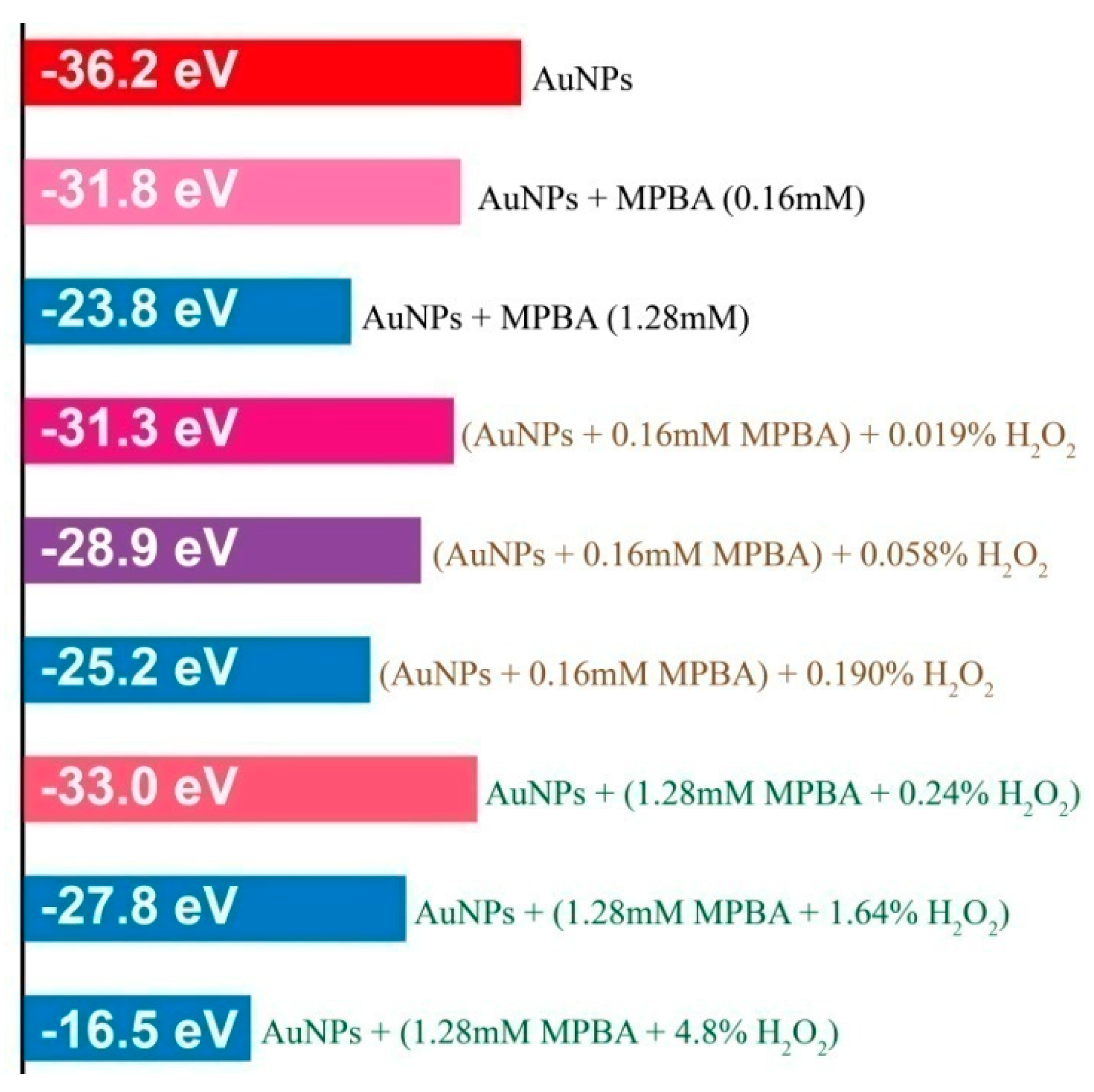

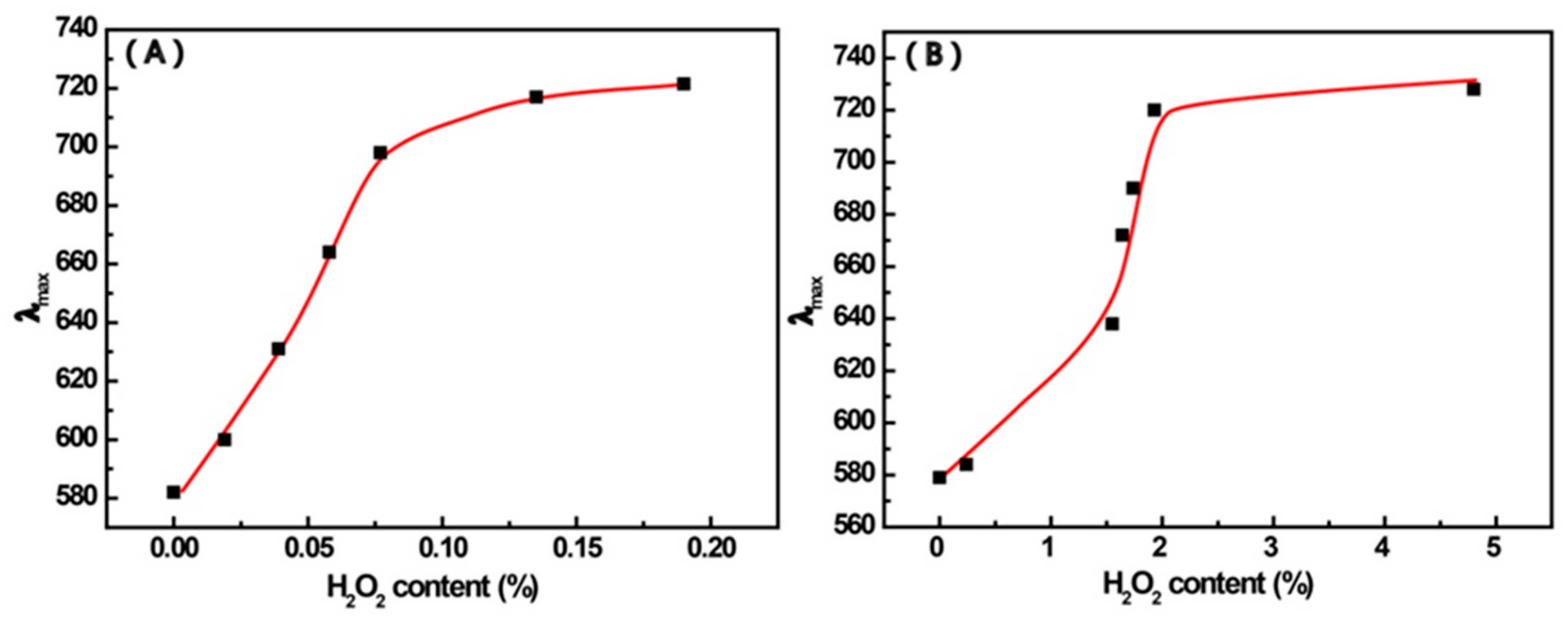
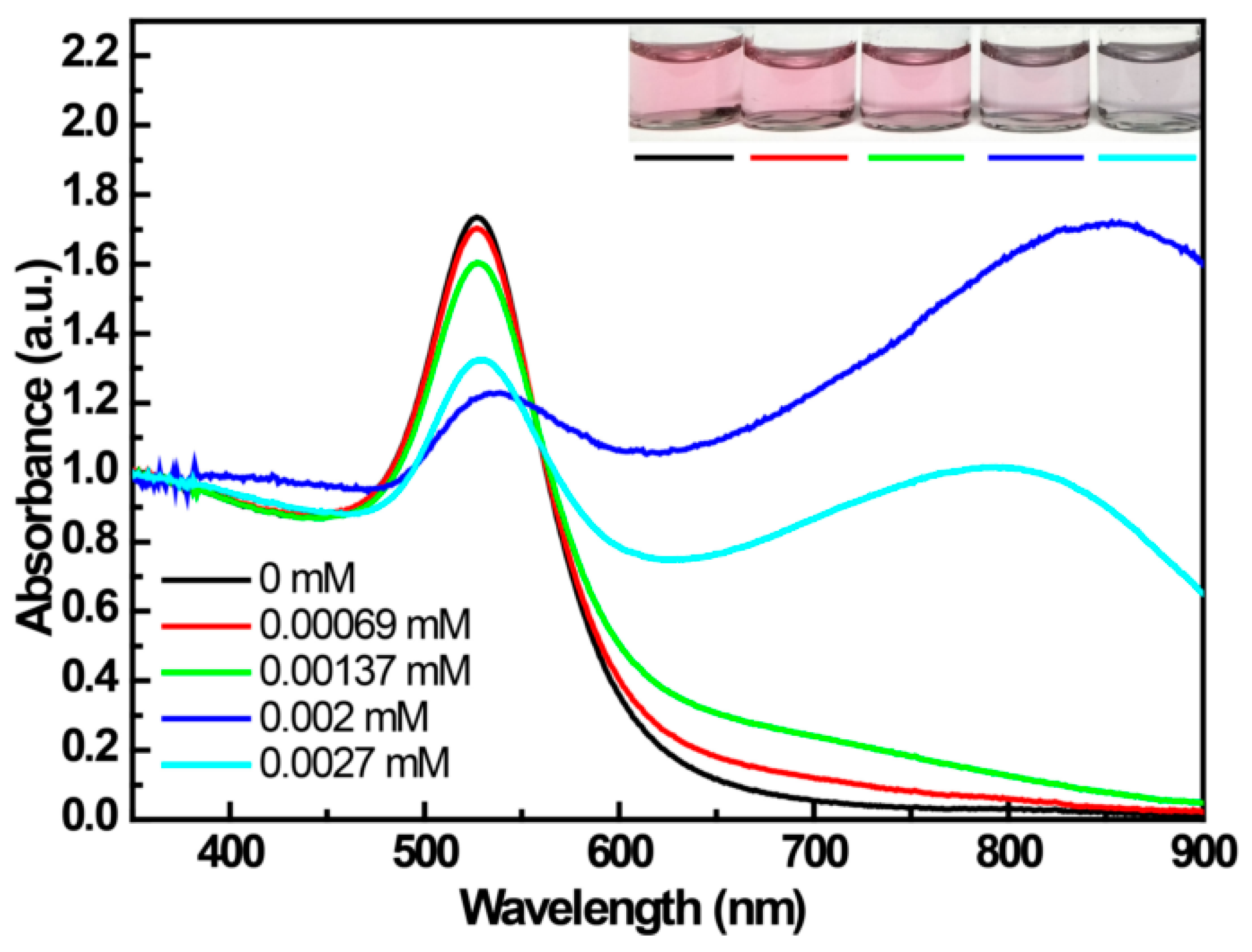
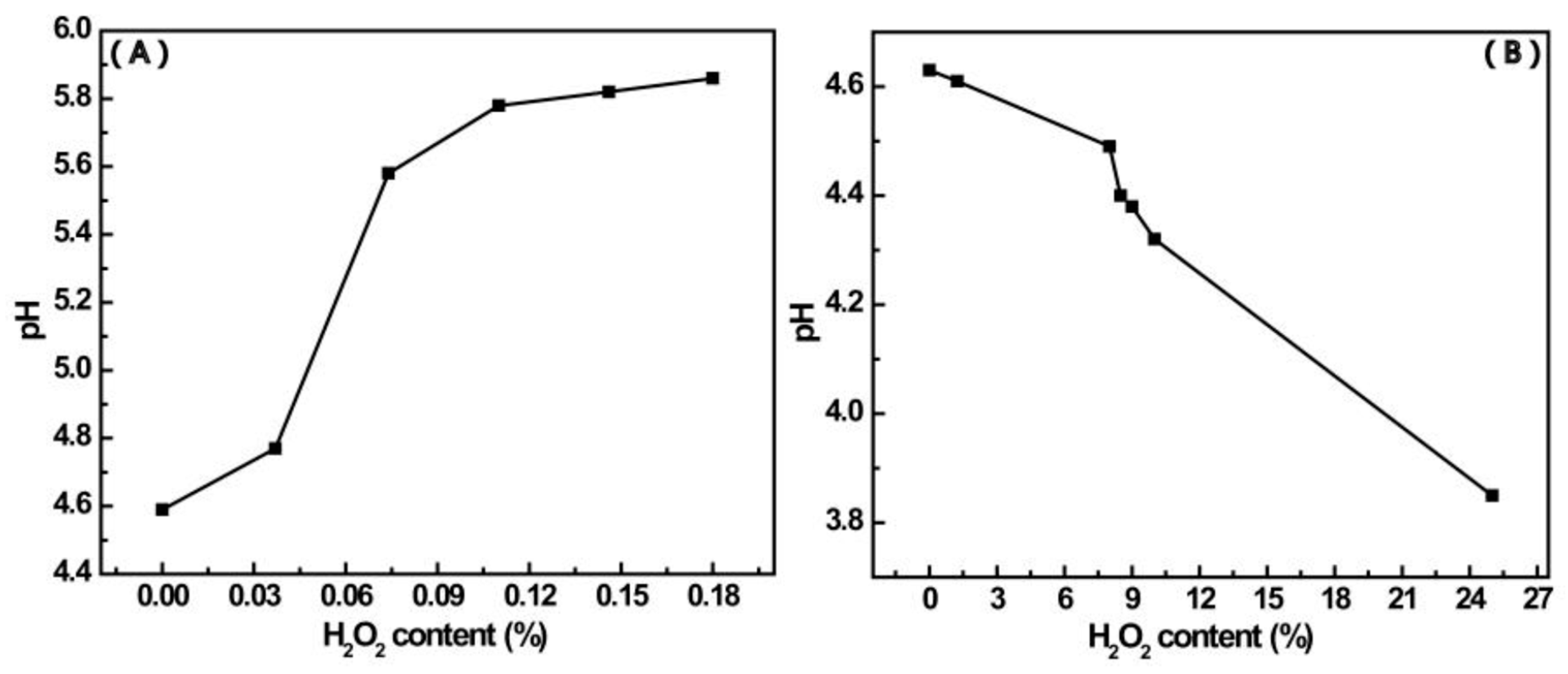
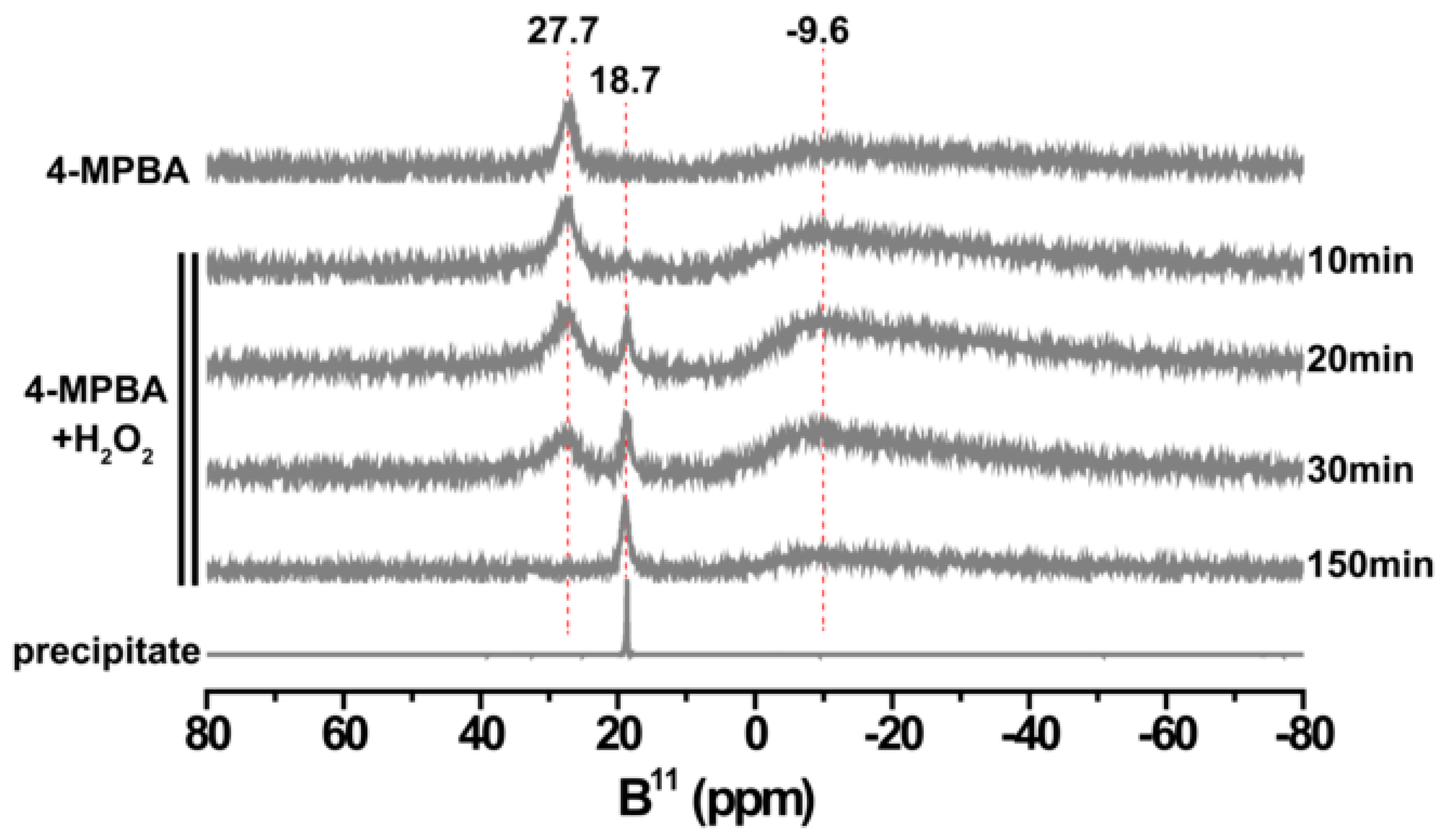
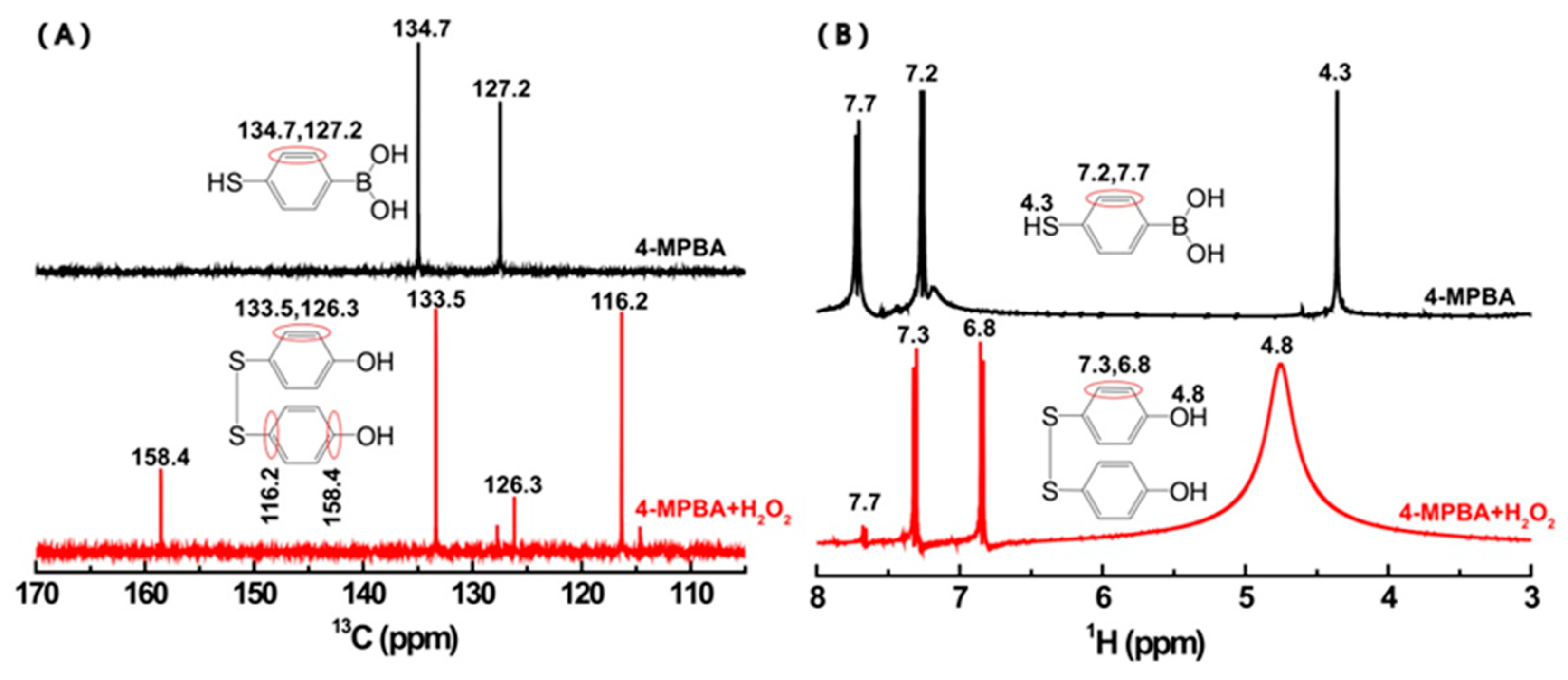
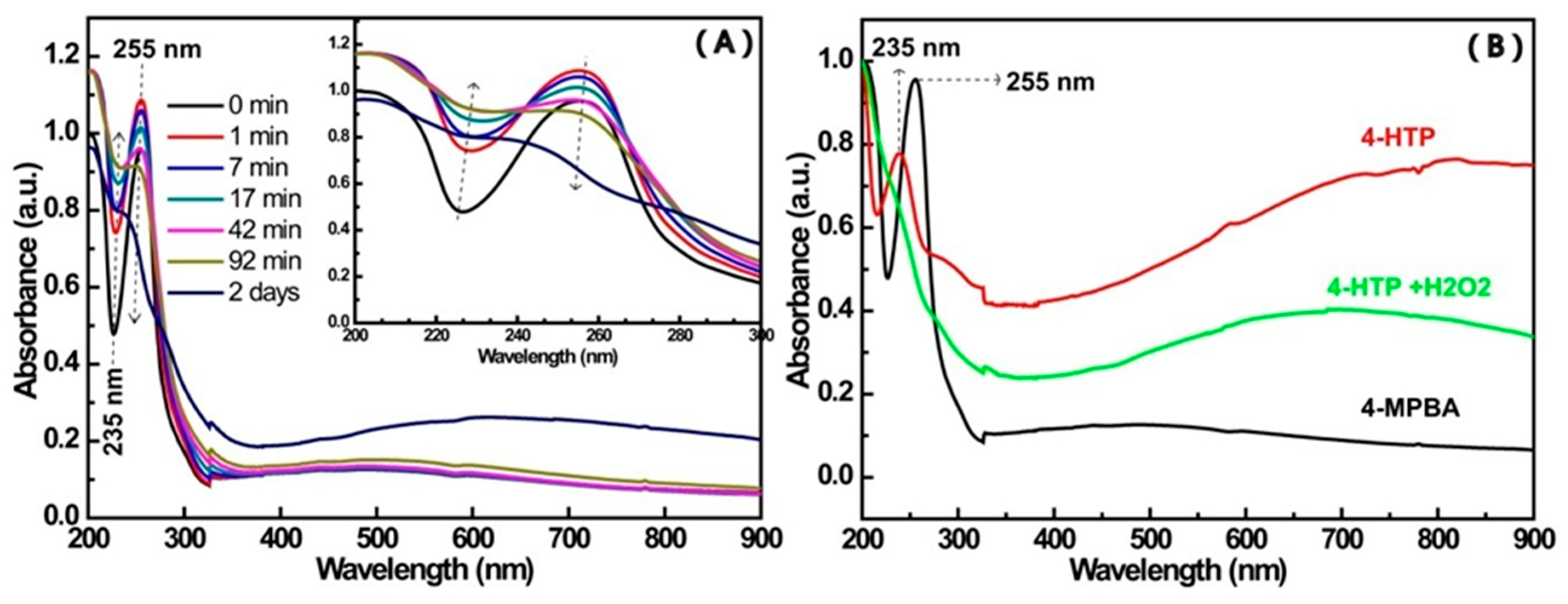
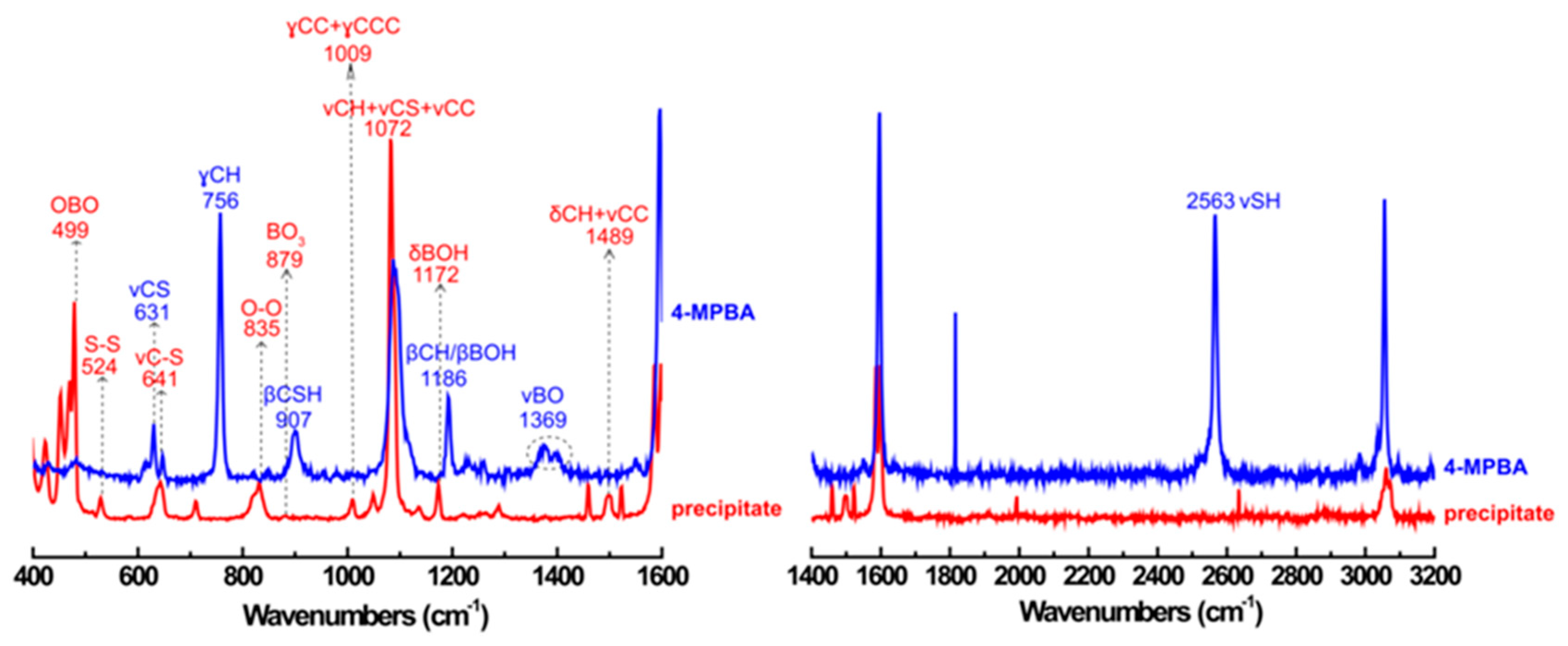
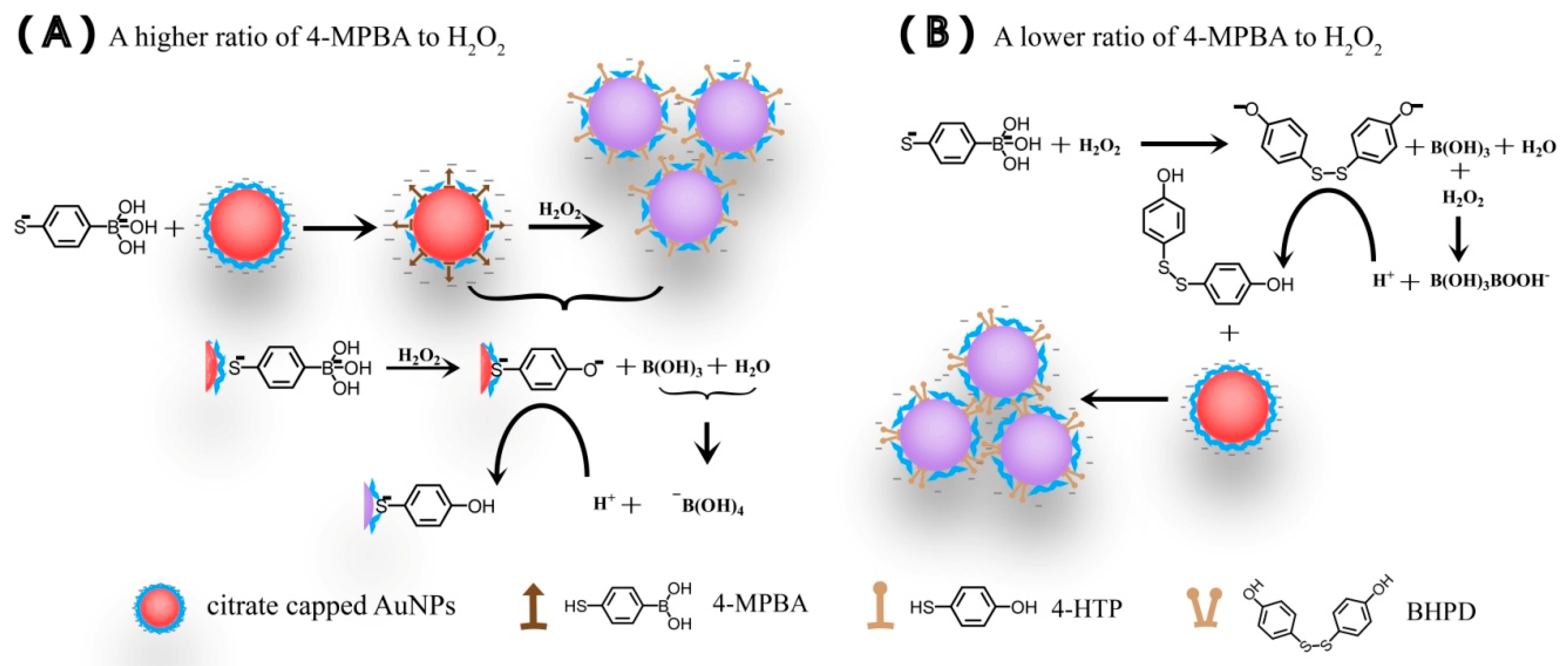
| Reactants | Mixt.1 a | Mixt.2 a | Mixt.3 | Mixt.4 b,d | Mixt.5 |
|---|---|---|---|---|---|
| 4-MPBA (mM) | 0.16 | 1.28 | 0.15 | --- | --- |
| 4-HTP (mM) | --- | --- | --- | 0~0.0027 | 0.07 |
| H2O2 (%) | 0~0.19% | 0~4.8% | 0.012% | ---- | ---- |
| H2O2 (2 mL) | --- | --- | --- | ---- | 0.012% |
| AuNPs (3 × 1012 NPs/mL) c | 500 μL | 500 μL | --- | 1 mL | --- |
| Reaction time (min) | 10 | 10 | 0~2 days | 5 | 20 |
© 2019 by the authors. Licensee MDPI, Basel, Switzerland. This article is an open access article distributed under the terms and conditions of the Creative Commons Attribution (CC BY) license (http://creativecommons.org/licenses/by/4.0/).
Share and Cite
Li, R.; Gu, X.; Liang, X.; Hou, S.; Hu, D. Aggregation of Gold Nanoparticles Caused in Two Different Ways Involved in 4-Mercaptophenylboronic Acidand Hydrogen Peroxide. Materials 2019, 12, 1802. https://doi.org/10.3390/ma12111802
Li R, Gu X, Liang X, Hou S, Hu D. Aggregation of Gold Nanoparticles Caused in Two Different Ways Involved in 4-Mercaptophenylboronic Acidand Hydrogen Peroxide. Materials. 2019; 12(11):1802. https://doi.org/10.3390/ma12111802
Chicago/Turabian StyleLi, Runmei, Xuefan Gu, Xingtang Liang, Shi Hou, and Daodao Hu. 2019. "Aggregation of Gold Nanoparticles Caused in Two Different Ways Involved in 4-Mercaptophenylboronic Acidand Hydrogen Peroxide" Materials 12, no. 11: 1802. https://doi.org/10.3390/ma12111802
APA StyleLi, R., Gu, X., Liang, X., Hou, S., & Hu, D. (2019). Aggregation of Gold Nanoparticles Caused in Two Different Ways Involved in 4-Mercaptophenylboronic Acidand Hydrogen Peroxide. Materials, 12(11), 1802. https://doi.org/10.3390/ma12111802




